Alessandro Suglia
Movie Facts and Fibs (MF$^2$): A Benchmark for Long Movie Understanding
Jun 06, 2025Abstract:Despite recent progress in vision-language models (VLMs), holistic understanding of long-form video content remains a significant challenge, partly due to limitations in current benchmarks. Many focus on peripheral, ``needle-in-a-haystack'' details, encouraging context-insensitive retrieval over deep comprehension. Others rely on large-scale, semi-automatically generated questions (often produced by language models themselves) that are easier for models to answer but fail to reflect genuine understanding. In this paper, we introduce MF$^2$, a new benchmark for evaluating whether models can comprehend, consolidate, and recall key narrative information from full-length movies (50-170 minutes long). MF$^2$ includes over 50 full-length, open-licensed movies, each paired with manually constructed sets of claim pairs -- one true (fact) and one plausible but false (fib), totalling over 850 pairs. These claims target core narrative elements such as character motivations and emotions, causal chains, and event order, and refer to memorable moments that humans can recall without rewatching the movie. Instead of multiple-choice formats, we adopt a binary claim evaluation protocol: for each pair, models must correctly identify both the true and false claims. This reduces biases like answer ordering and enables a more precise assessment of reasoning. Our experiments demonstrate that both open-weight and closed state-of-the-art models fall well short of human performance, underscoring the relative ease of the task for humans and their superior ability to retain and reason over critical narrative information -- an ability current VLMs lack.
Playpen: An Environment for Exploring Learning Through Conversational Interaction
Apr 11, 2025Abstract:Are we running out of learning signal? Predicting the next word in an existing text has turned out to be a powerful signal, at least at scale. But there are signs that we are running out of this resource. In recent months, interaction between learner and feedback-giver has come into focus, both for "alignment" (with a reward model judging the quality of instruction following attempts) and for improving "reasoning" (process- and outcome-based verifiers judging reasoning steps). In this paper, we explore to what extent synthetic interaction in what we call Dialogue Games -- goal-directed and rule-governed activities driven predominantly by verbal actions -- can provide a learning signal, and how this signal can be used. We introduce an environment for producing such interaction data (with the help of a Large Language Model as counterpart to the learner model), both offline and online. We investigate the effects of supervised fine-tuning on this data, as well as reinforcement learning setups such as DPO, and GRPO; showing that all of these approaches achieve some improvements in in-domain games, but only GRPO demonstrates the ability to generalise to out-of-domain games as well as retain competitive performance in reference-based tasks. We release the framework and the baseline training setups in the hope that this can foster research in this promising new direction.
Triangulating LLM Progress through Benchmarks, Games, and Cognitive Tests
Feb 20, 2025Abstract:We examine three evaluation paradigms: large question-answering benchmarks (e.g., MMLU and BBH), interactive games (e.g., Signalling Games or Taboo), and cognitive tests (e.g., for working memory or theory of mind). First, we investigate which of the former two-benchmarks or games-is most effective at discriminating LLMs of varying quality. Then, inspired by human cognitive assessments, we compile a suite of targeted tests that measure cognitive abilities deemed essential for effective language use, and we investigate their correlation with model performance in benchmarks and games. Our analyses reveal that interactive games are superior to standard benchmarks in discriminating models. Causal and logical reasoning correlate with both static and interactive tests, while differences emerge regarding core executive functions and social/emotional skills, which correlate more with games. We advocate the development of new interactive benchmarks and targeted cognitive tasks inspired by assessing human abilities but designed specifically for LLMs.
CROPE: Evaluating In-Context Adaptation of Vision and Language Models to Culture-Specific Concepts
Oct 20, 2024Abstract:As Vision and Language models (VLMs) become accessible across the globe, it is important that they demonstrate cultural knowledge. In this paper, we introduce CROPE, a visual question answering benchmark designed to probe the knowledge of culture-specific concepts and evaluate the capacity for cultural adaptation through contextual information. This allows us to distinguish between parametric knowledge acquired during training and contextual knowledge provided during inference via visual and textual descriptions. Our evaluation of several state-of-the-art open VLMs shows large performance disparities between culture-specific and common concepts in the parametric setting. Moreover, experiments with contextual knowledge indicate that models struggle to effectively utilize multimodal information and bind culture-specific concepts to their depictions. Our findings reveal limitations in the cultural understanding and adaptability of current VLMs that need to be addressed toward more culturally inclusive models.
Repairs in a Block World: A New Benchmark for Handling User Corrections with Multi-Modal Language Models
Sep 21, 2024Abstract:In dialogue, the addressee may initially misunderstand the speaker and respond erroneously, often prompting the speaker to correct the misunderstanding in the next turn with a Third Position Repair (TPR). The ability to process and respond appropriately to such repair sequences is thus crucial in conversational AI systems. In this paper, we first collect, analyse, and publicly release BlockWorld-Repairs: a dataset of multi-modal TPR sequences in an instruction-following manipulation task that is, by design, rife with referential ambiguity. We employ this dataset to evaluate several state-of-the-art Vision and Language Models (VLM) across multiple settings, focusing on their capability to process and accurately respond to TPRs and thus recover from miscommunication. We find that, compared to humans, all models significantly underperform in this task. We then show that VLMs can benefit from specialised losses targeting relevant tokens during fine-tuning, achieving better performance and generisability. Our results suggest that these models are not yet ready to be deployed in multi-modal collaborative settings where repairs are common, and highlight the need to design training regimes and objectives that facilitate learning from interaction.
Shaking Up VLMs: Comparing Transformers and Structured State Space Models for Vision & Language Modeling
Sep 09, 2024

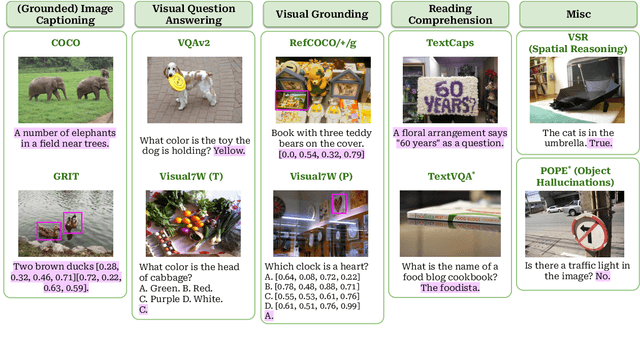

Abstract:This study explores replacing Transformers in Visual Language Models (VLMs) with Mamba, a recent structured state space model (SSM) that demonstrates promising performance in sequence modeling. We test models up to 3B parameters under controlled conditions, showing that Mamba-based VLMs outperforms Transformers-based VLMs in captioning, question answering, and reading comprehension. However, we find that Transformers achieve greater performance in visual grounding and the performance gap widens with scale. We explore two hypotheses to explain this phenomenon: 1) the effect of task-agnostic visual encoding on the updates of the hidden states, and 2) the difficulty in performing visual grounding from the perspective of in-context multimodal retrieval. Our results indicate that a task-aware encoding yields minimal performance gains on grounding, however, Transformers significantly outperform Mamba at in-context multimodal retrieval. Overall, Mamba shows promising performance on tasks where the correct output relies on a summary of the image but struggles when retrieval of explicit information from the context is required.
Investigating the Role of Instruction Variety and Task Difficulty in Robotic Manipulation Tasks
Jul 04, 2024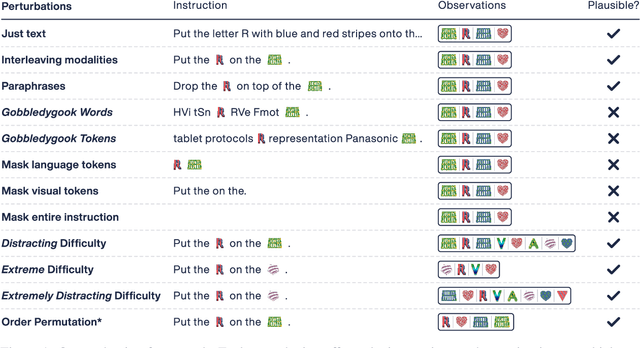
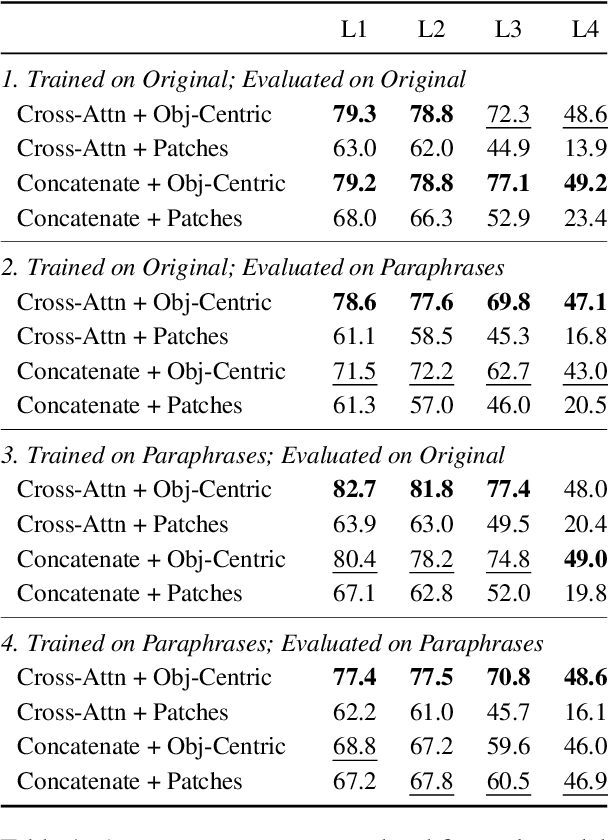
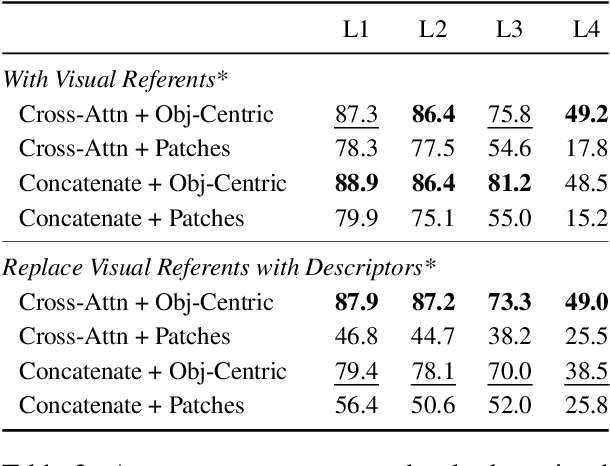
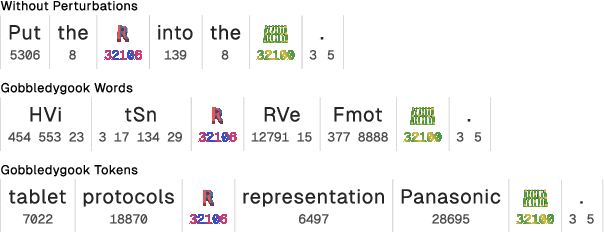
Abstract:Evaluating the generalisation capabilities of multimodal models based solely on their performance on out-of-distribution data fails to capture their true robustness. This work introduces a comprehensive evaluation framework that systematically examines the role of instructions and inputs in the generalisation abilities of such models, considering architectural design, input perturbations across language and vision modalities, and increased task complexity. The proposed framework uncovers the resilience of multimodal models to extreme instruction perturbations and their vulnerability to observational changes, raising concerns about overfitting to spurious correlations. By employing this evaluation framework on current Transformer-based multimodal models for robotic manipulation tasks, we uncover limitations and suggest future advancements should focus on architectural and training innovations that better integrate multimodal inputs, enhancing a model's generalisation prowess by prioritising sensitivity to input content over incidental correlations.
Enhancing Continual Learning in Visual Question Answering with Modality-Aware Feature Distillation
Jun 27, 2024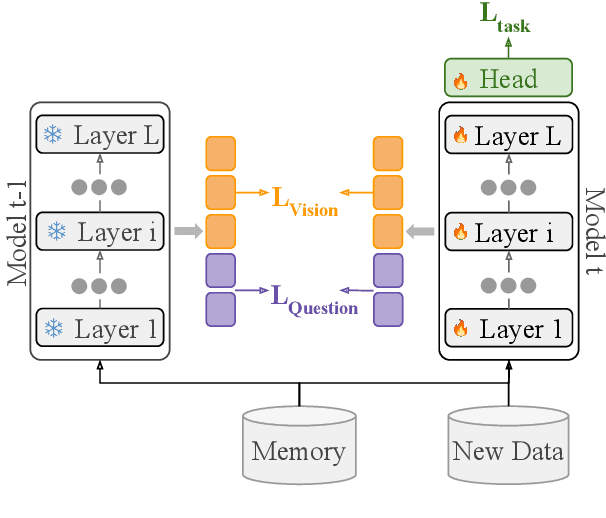
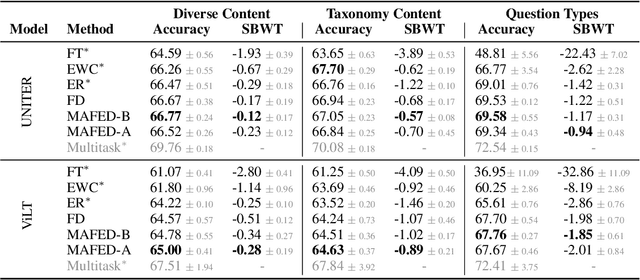
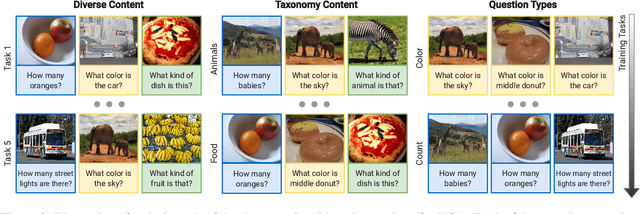

Abstract:Continual learning focuses on incrementally training a model on a sequence of tasks with the aim of learning new tasks while minimizing performance drop on previous tasks. Existing approaches at the intersection of Continual Learning and Visual Question Answering (VQA) do not study how the multimodal nature of the input affects the learning dynamics of a model. In this paper, we demonstrate that each modality evolves at different rates across a continuum of tasks and that this behavior occurs in established encoder-only models as well as modern recipes for developing Vision & Language (VL) models. Motivated by this observation, we propose a modality-aware feature distillation (MAFED) approach which outperforms existing baselines across models of varying scale in three multimodal continual learning settings. Furthermore, we provide ablations showcasing that modality-aware distillation complements experience replay. Overall, our results emphasize the importance of addressing modality-specific dynamics to prevent forgetting in multimodal continual learning.
LLMs instead of Human Judges? A Large Scale Empirical Study across 20 NLP Evaluation Tasks
Jun 26, 2024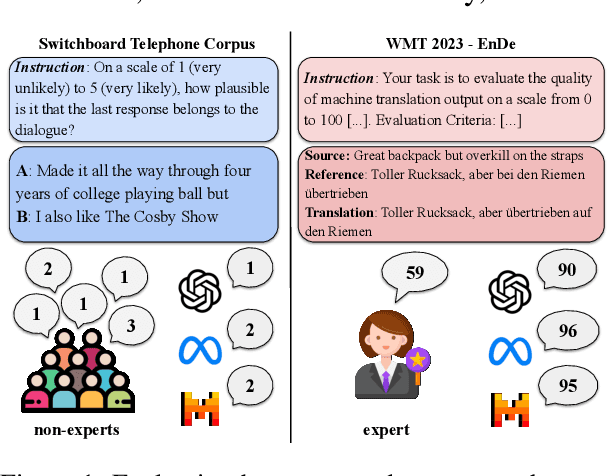
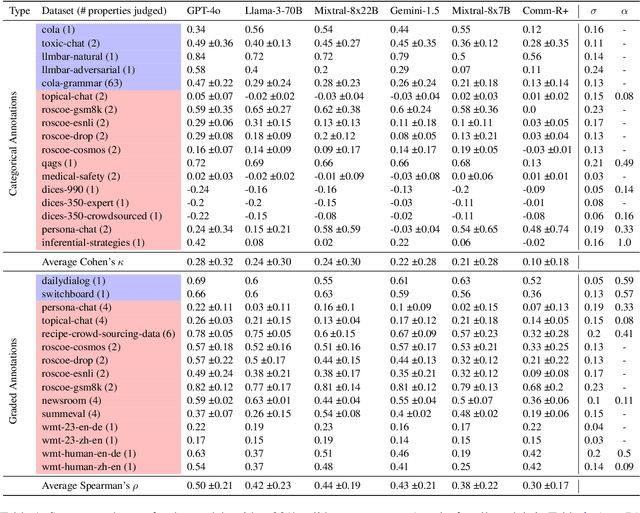
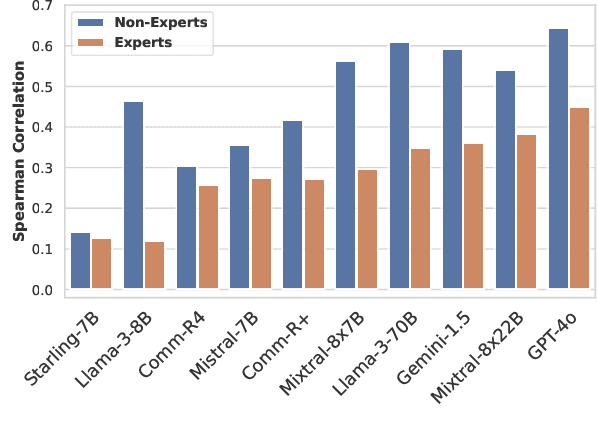
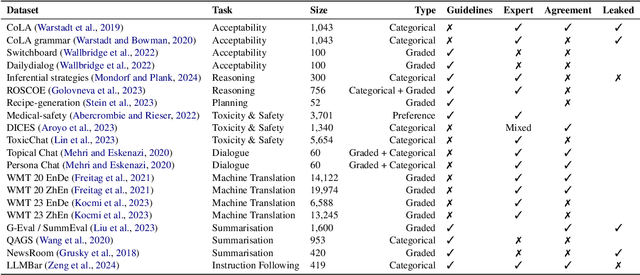
Abstract:There is an increasing trend towards evaluating NLP models with LLM-generated judgments instead of human judgments. In the absence of a comparison against human data, this raises concerns about the validity of these evaluations; in case they are conducted with proprietary models, this also raises concerns over reproducibility. We provide JUDGE-BENCH, a collection of 20 NLP datasets with human annotations, and comprehensively evaluate 11 current LLMs, covering both open-weight and proprietary models, for their ability to replicate the annotations. Our evaluations show that each LLM exhibits a large variance across datasets in its correlation to human judgments. We conclude that LLMs are not yet ready to systematically replace human judges in NLP.
AlanaVLM: A Multimodal Embodied AI Foundation Model for Egocentric Video Understanding
Jun 19, 2024Abstract:AI personal assistants deployed via robots or wearables require embodied understanding to collaborate with humans effectively. However, current Vision-Language Models (VLMs) primarily focus on third-person view videos, neglecting the richness of egocentric perceptual experience. To address this gap, we propose three key contributions. First, we introduce the Egocentric Video Understanding Dataset (EVUD) for training VLMs on video captioning and question answering tasks specific to egocentric videos. Second, we present AlanaVLM, a 7B parameter VLM trained using parameter-efficient methods on EVUD. Finally, we evaluate AlanaVLM's capabilities on OpenEQA, a challenging benchmark for embodied video question answering. Our model achieves state-of-the-art performance, outperforming open-source models including strong Socratic models using GPT-4 as a planner by 3.6%. Additionally, we outperform Claude 3 and Gemini Pro Vision 1.0 and showcase competitive results compared to Gemini Pro 1.5 and GPT-4V, even surpassing the latter in spatial reasoning. This research paves the way for building efficient VLMs that can be deployed in robots or wearables, leveraging embodied video understanding to collaborate seamlessly with humans in everyday tasks, contributing to the next generation of Embodied AI
 Add to Chrome
Add to Chrome Add to Firefox
Add to Firefox Add to Edge
Add to Edge